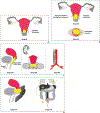Staging of Cervical Cancer: A Practical Approach Using MRI and FDG PET
- PMID: 37459457
- PMCID: PMC467038
- DOI: 10.2214/AJR.23.29003
Staging of Cervical Cancer: A Practical Approach Using MRI and FDG PET
Abstract
This review provides a practical approach to the imaging evaluation of patients with cervical cancer (CC), from initial diagnosis to restaging of recurrence, focusing on MRI and FDG PET. The primary updates to the International Federation of Gynecology and Obstetrics (FIGO) CC staging system, as well as these updates' relevance to clinical management, are discussed. The recent literature investigating the role of MRI and FDG PET in CC staging and image-guided brachytherapy is summarized. The utility of MRI and FDG PET in response assessment and posttreatment surveillance is described. Important findings on MRI and FDG PET that interpreting radiologists should recognize and report are illustrated. The essential elements of structured reports during various phases of CC management are outlined. Special considerations, including the role of imaging in patients desiring fertility-sparing management, differentiation of CC and endometrial cancer, and unusual CC histologies, are also described. Finally, future research directions including PET/MRI, novel PET tracers, and artificial intelligence applications are highlighted.
Keywords: MRI; PET; cervical cancer; gynecologic cancer; imaging.
Figures












Comment in
-
Editorial Comment: On the Contemporary Role of MRI and FDG PET/CT in Managing Cervical Cancer.AJR Am J Roentgenol. 2023 Nov;221(5):648. doi: 10.2214/AJR.23.29755. Epub 2023 Jun 14. AJR Am J Roentgenol. 2023. PMID: 37315016 No abstract available.
References
-
- Sung H, Ferlay J, Siegel RL, et al. Global cancer statistics 2020: GLOBOCAN estimates of incidence and mortality worldwide for 36 cancers in 185 countries. CA Cancer J Clin 2021; 71:209–249 - PubMed
-
- Lei J, Ploner A, Elfström KM, et al. HPV vaccination and the risk of invasive cervical cancer. N Engl J Med 2020; 383:1340–1348 - PubMed
-
- WHO website. Cervical cancer. www.who.int/news-room/fact-sheets/detail/cervical-cancer. Published Feb 22, 2022. Accessed Nov 7, 2022
-
- Parra-Herran C Cervix: WHO classification. PathologyOutlines.com website. www.pathologyoutlines.com/topic/cervixWHO.html. Last updated May 28, 2021. Accessed Nov 7, 2022

